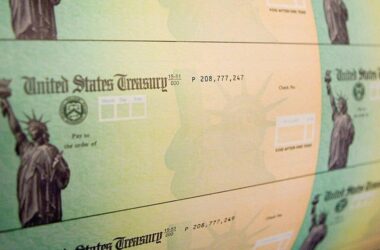With the Federal Open Market Committee (FOMC) cutting interest rates by a larger-than-expected 50 basis points in its September meeting, businesses throughout the country will be able to take out loans more cheaply. One intended goal of a rate cut like this is to foster increased profitability through business expansion. While many categories of stocks could theoretically benefit from a rate cut, some are better-positioned than others due to debt loads, links to consumer spending, and dividend structures.
Selecting individual names most likely to benefit from a rate cut can be difficult, so many investors mitigate risk and diversify their holdings by targeting exchange-traded funds (ETFs) instead. Some ETFs may provide a buffer against the possibility of a market slump due to concerns about cooling labor figures and the strength of the dollar.
IJR: Small-Caps Could Benefit From Easier Conditions, Lower Lending Costs
IJRiShares Core S&P Small-Cap ETF$116.95 -1.17 (-0.99%) (As of 09/20/2024 ET)52-Week Range$87.32▼$120.74Dividend Yield1.15%Assets Under Management$87.02 billion
Small-cap stocks tend to be beneficiaries of rate cuts because of their reliance on floating-rate debt. Many of these companies do not have the balance sheets to be able to sustain operations and growth without taking on significant debt. However, reduced borrowing costs and easier financial conditions could help these companies, in particular, to expand their footprints. The small-cap-focused Russell 2000 has climbed by more than 22% in the last year in anticipation of a rate cut.
The iShares Core S&P Small-Cap ETF NYSEARCA: IJR holds a broad basket of more than 600 small-cap stocks, effectively managing some of the risk that is commonly associated with individual companies of this size. IJR also offers investors access to a variety of sectors for further diversification—likely a useful approach given post-rate cut sector rotation—as well as a low expense ratio of 0.06%.
VWO: Inflow Potential to Emerging Markets
VWOVanguard FTSE Emerging Markets ETF$45.29 -0.03 (-0.07%) (As of 09/20/2024 ET)52-Week Range$37.46▼$45.72Dividend Yield3.53%Assets Under Management$79.98 billion
When the FOMC cuts interest rates, it can help to ease the pressure on exchange rates for emerging markets. Lowered U.S. borrowing costs may also strengthen foreign capital inflows into these markets. The signals from the Federal Reserve that rate cuts were looming were enough to prompt Indonesia’s central bank to cut its own rates before the FOMC’s September meeting.The Vanguard FTSE Emerging Markets ETF NYSEARCA: VWO offers a cheaper alternative to many other emerging markets funds as well as broad exposure to companies and sectors around the world. The fund’s asset base and trading volume averages support both active trading and buy-and-hold investing styles. VWO is up more than 13% in the last year, which is shy of benchmarks like the S&P 500, although this may indicate that there is still growth potential in the emerging markets space that has not already been priced in.
PFFD: Capitalize on Strong Dividends
PFFDGlobal X U.S. Preferred ETF$20.94 -0.03 (-0.14%) (As of 05:14 PM ET)52-Week Range$17.37▼$20.97Dividend Yield6.48%Assets Under Management$2.52 billion
Preferred shares of companies tend to benefit alongside other stocks when interest rates fall. Add to this the potential for higher-than-usual dividends from these stocks, and they will become an even more attractive prospect following the Fed’s rate cuts. High-dividend-yield stocks in interest-rate-sensitive industries also tend to carry large volumes of debt, so they too stand to benefit from an interest rate cut.
The Global X U.S. Preferred ETF NYSEARCA: PFFD holds more than 200 preferred stocks with a focus on utilities companies and banks, both of which stand to benefit from a more favorable low-interest rate scenario. PFFD also balances strong dividend payout with an expense ratio lower than some of its peers, helping to ensure that investors do not lose out on passive dividend income due to fund fees.
What Follows the Rate Cut?
A larger-than-expected rate cut could be a major boon to stocks across sectors, which could help to drive growth in each of the above ETFs. At the same time, investors should be mindful of the potential that an upfront rate cut combined with concerns about the labor market may spark a recession. This is why, despite the fact that many ETFs are designed to make investing easy for buy-and-hold investors, it may be worthwhile to take a more proactive approach to monitoring ETF performance in the weeks and months following the Fed’s announcement to trim rates. On the other hand, if the rate cut has its intended effect and prompts a continued surge in the markets, these funds will position investors well to take advantage of those gains.Before you consider Global X U.S. Preferred ETF, you’ll want to hear this.MarketBeat keeps track of Wall Street’s top-rated and best performing research analysts and the stocks they recommend to their clients on a daily basis. MarketBeat has identified the five stocks that top analysts are quietly whispering to their clients to buy now before the broader market catches on… and Global X U.S. Preferred ETF wasn’t on the list.View The Five Stocks Here MarketBeat’s analysts have just released their top five short plays for September 2024. Learn which stocks have the most short interest and how to trade them. Click the link below to see which companies made the list.Get This Free Report
Like this article? Share it with a colleague.
Link copied to clipboard.





